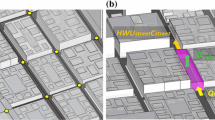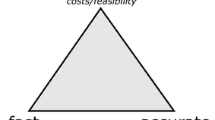Abstract
The transport of a passive scalar from a continuous point-source release in an urban street network is studied using direct numerical simulation (DNS). Dispersion through the network is characterized by evaluating horizontal fluxes of scalar within and above the urban canopy and vertical exchange fluxes through the canopy top. The relative magnitude and balance of these fluxes are used to distinguish three different regions relative to the source location: a near-field region, a transition region and a far-field region. The partitioning of each of these fluxes into mean and turbulent parts is computed. It is shown that within the canopy the horizontal turbulent flux in the street network is small, whereas above the canopy it comprises a significant fraction of the total flux. Vertical fluxes through the canopy top are predominantly turbulent. The mean and turbulent fluxes are respectively parametrized in terms of an advection velocity and a detrainment velocity and the parametrization incorporated into a simple box-network model. The model treats the coupled dispersion problem within and above the street network in a unified way and predictions of mean concentrations compare well with the DNS data. This demonstrates the usefulness of the box-network approach for process studies and interpretation of results from more detailed numerical simulations.









Similar content being viewed by others
References
Belcher S (2005) Mixing and transport in urban areas. Phil Trans R Soc 363:2947–2968
Belcher S, Coceal O, Goulart E, Rudd A, Robins A (2015) Processes controlling atmospheric dispersion through city centres. J Fluid Mech 763:51–81
Branford S, Coceal O, Thomas T, Belcher S (2011) Dispersion of a point-source release of a passive scalar through an urban-like array for different wind directions. Boundary-Layer Meteorol 139:367–394
Britter R, Hanna S (2003) Flow and dispersion in urban areas. Annu Rev Fluid Mech 35:469–496
Carpentieri M, Robins A, Baldi S (2009) Three-dimensional mapping of air flow at an urban canyon intersection. Boundary-Layer Meteorol 133:277–296
Coceal O, Dobre A, Thomas T, Belcher S (2007) Mixing and transport in urban areas. J Fluid Mech 589:375–409
Coceal O, Goulart E, Branford S, Thomas T, Belcher S (2014) Flow structure and near-field dispersion in arrays of building-like obstacles. J Wind Eng Ind Aerodyn 125:52–68
Davidson M, Mylne K, Jones C, Phillips J, Perkins R (1995) Plume dispersion through large groups of obstacles a field investigation. Atmos Environ 29:3245–3256
Davidson M, Snyder WH, Lawson R, Hunt J (1996) Wind tunnel simulations of plume dispersion through groups of obstacles. Atmos Environ 30:3715–3725
Goulart E (2012) Flow and dispersion in urban areas. PhD thesis, University of Reading
Goulart E, Coceal O, Belcher S (2016) Spatial and temporal variability of the concentration field from localized releases in a regular building array. Boundary-Layer Meteorol 159:241–257
Hamlyn D, Hilderman T, Britter R (2007) A simple network approach to modelling dispersion among large groups of obstacle. Atmos Environ 41:5848–5862
Hanna S, Tehranian S, Carissimo B, Macdonald R, Lohner R (2002) Comparisons of model simulations with observations of mean flow and turbulence within simple obstacle arrays. Atmos Environ 36:5067–5079
Hilderman T, Chong R, Kiel D (2007) A laboratory study of momentum and passive scalar transport and diffusion within and above a model urban canopy. Final report Contract Report DRDC Suffield CR 2008-025
Macdonald R, Griffiths R, Cheah S (1997) Field experiments of dispersion through regular arrays of cubic structures. Atmos Environ 31:783–795
Macdonald R, Griffiths R, Hall D (1998) A comparison of results from scaled field and wind tunnel modelling of dispersion in arrays of obstacles. Atmos Environ 32:3845–3862
Milliez M, Carissimo B (2007) Numerical simulations of pollutant dispersion in an idealised urban area, for different meteorological conditions. Boundary-Layer Meteorol 122:321–342
Pasquill F (1962) Atmospheric diffusion. The dispersion of windbourne material from industrial and other sources. D. van Nostrand Company Ltd, New York
Philips D, Rossi R, Iaccarino G (2013) Large-eddy simulation of passive scalar dispersion in an urban-like canopy. J Fluid Mech 723:404–428
Soulhac L (2000) Modelisation de la dispersion atmospheric a l’interieur de la canopee urbaine. PhD thesis, Ecole Centrale de Lyon
Soulhac L, Salizzoni P, Cierco FX, Perkins R (2011) The model SIRANE for atmospheric urban pollution dispersion: part I, presentation of the model. Atmos Environ 45(39):7379–7395
Soulhac L, Salizzoni P, Mejean P, Didier D, Rios I (2012) The model SIRANE for atmospheric urban pollutant dispersion: part II, validation of the model on a real case study. Atmos Environ 320–337:49
Soulhac L, Lamaison G, Cierco FX, Salem NB, Salizzoni P, Mejean P, Armand P, Patryll L (2016) SIRANERISK: modelling dispersion of steady and unsteady pollutant releases in the urban canopy. Atmos Environ 140:242–260
Vincent J (1978) Model experiments on the nature of air pollution transport near buildings. Atmos Environ 11:765–774
Yee E, Biltoft C (2004) Concentration fluctuation measurements in a plume dispersing through a regular array of obstacles. Boundary-Layer Meteorol 111:363–415
Yee E, Gailis R, Hill A, Hilderman T, Kiel D (2006) Comparison of wind tunnel and water-channel simulations of plume dispersion through a large array of obstacles with a scaled field experiment. Boundary-Layer Meteorol 121:389–432
Acknowledgements
Elisa V. Goulart gratefully acknowledges funding from National Council for Scientific and Technological Development (CNPq) and Espirito Santo Research Foundation (FAPES), Brazil. Omduth Coceal gratefully acknowledges funding from the Natural Environment Research Council (NERC) through their National Centre for Atmospheric Science (NCAS) under Grant No. R8/H12/83/002 and from the Engineering and Physical Sciences Research Council (EPSRC Contract No. EP/K040707/1).
Author information
Authors and Affiliations
Corresponding author
Rights and permissions
About this article
Cite this article
Goulart, E.V., Coceal, O. & Belcher, S.E. Dispersion of a Passive Scalar Within and Above an Urban Street Network. Boundary-Layer Meteorol 166, 351–366 (2018). https://doi.org/10.1007/s10546-017-0315-5
Received:
Accepted:
Published:
Issue Date:
DOI: https://doi.org/10.1007/s10546-017-0315-5




